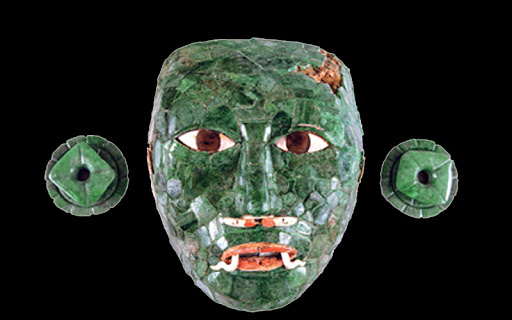Mask of the red queen A.D 670 Mexico
One of the richest known burials of the Mayan women monarch is the funeral assemblage of Palenque’s Lady Tz’akbu Ajaw, nicknamed the Red Queen as it was discovered to be covered in cinnabar.
Her sarcophagus was in Temple XIII, next to the Temple of the Inscriptions, where her husband, K’inich Janaab Pakal I, was entombed; her malachite funerary mask echoes his jadeite version.
She also wore a headdress ornamented with shell eyes and fangs, probably representing a deity, and a necklace of multicolored beads. A Spondylus shell containing a limestone figurine probably represents a dedicatory offering performed when the queen was laid to rest.

The funeral complex of Tz’akbu Ajaw, the lady of Palenque called the Red Queen for having been found covered in cinnabar, comes from one of the most sumptuous tombs of a female Mayan ruler.
Her sarcophagus was located in Temple XIII, located next to the Temple of the Inscriptions where her husband K’inich Janaab Pakal I was buried. Her malachite face mask evokes her husband’s jade version.
She was also wearing a headdress adorned with shell eyes and fangs, probably to represent a deity, as well as a multi-colored bead necklace. A Spondylus shell containing a limestone figurine may represent a dedicatory offering made for the queen’s burial.

Who Was the Red Queen?
The researchers called the woman found in the tomb the ”Red Queen”. Her remains were transported to the laboratory of the Mexican National Institute of Archaeology and History.
Researchers found that she lived between 600 and 700 AD – a date suggested by the pottery discovered inside the tomb.
The analysis included carbon 14 testing and facial reconstruction. With this, the team found that the woman died when she was about sixty years old and had osteoporosis. Moreover, her diet was revealed to be based mostly on meat.
She also had very healthy teeth, something that was not typical for the Maya people during that time.
Although the burial was a magnificent discovery, the researchers couldn’t hide their disappointment: Inside the chamber, they did not find any inscription or indication which could allow them to confirm her name.
The researcher Arnoldo Gonzalez Cruz believes that she was Tz’ak-bu Ajaw, the wife of Pakal and the grandmother of the last Mayan king.
Currently, the team is looking for the tombs of Pakal and his sons. Comparing the DNA of the woman with Pakal’s sons could help them with this hypothesis.

The Legendary City of Palenque
Palenque was called Lekamha by the Maya people. This word means ”Big Water”. It was an impressive city which was built around the 3rd century BC and was inhabited until the end of the 8th century AD.
This was a political center and the capital for many male and female rulers. Now the site is located in a part of the state of Chiapas. It covers up to 2.5 square kilometers (1 square mile). Archaeologists claim that only 10% of the ancient city of Palenque has been explored so far.

Apart from the tomb of the Red Queen, another important discovery has been the tomb of K’inich Janaab Pakal, also known as Pacal the Great. He ruled during the 7th century AD and was buried in the temple called The Temple of the Inscriptions.
